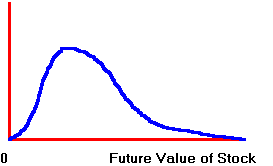![]() 6.3
Stock Price Dynamics
6.3
Stock Price Dynamics
Here
we introduce a model of stock price behavior over time that allows for
uncertainty.
The
Certainty Case Revisited
In
the certainty case, the stock price at the time of the option's maturity,
T, equals the future value of the stock price S when continuously compounded at the risk-free interest rate r:
![]()
One
way to think about this is that the future value is the
end result of a dynamic process. That
is, the stock price starts at S at the
present time 0, and evolves through time
to its future value.
The
formal expression that describes how the stock price moves through time in the
certainty case can be obtained by employing a little calculus:
![]()
This
says that the rate of change of the
stock price over time is proportional to the stock price at time t. The derivation of
this representation is provided in Appendix D, topic D.1, Stock Price Dynamics: Certainty
Model.
The
expression above describes the dynamic
stock price process in a world with certainty.
Multiplying both sides by dt
and rearranging, we can rewrite the
equation as:
![]()
In
this form, r is the instantaneous rate of
return on the stock. Here,
r is also called the drift
rate of the stock price process.
If instantaneous return is r
then the logarithm of this return is a continuously compounded return.
For the case of no uncertainty the drift rate for the logarithm of this
process is the same but in an uncertain world this is not the case.
Uncertainty
Case
To
model the uncertainty case, we make two changes to Equation 6-1.
First, we relax the requirement that the instantaneous return from the
stock is the risk-free interest rate. In
a world with uncertainty and risk-averse investors, we expect that the
instantaneous return from the stock ( m )
will exceed the instantaneous risk-free rate of return (i.e., m > r).
Second,
we add a source of randomness to the instantaneous rate of return that has
statistical properties that capture the fact that observed stock prices vary,
and that a typical stock price path has variance that increases with time. An
example is displayed in Figure 6.1.
Figure 6.1
Stock Price Dynamics with Uncertainty

Black
and Scholes assume a model for stock price dynamics that is formally described
as geometric Brownian motion (see Appendix D, topic D.5, Distribution
of Stock Prices). This model
has the following form:
![]()
Here
there are two factors that affect the instantaneous rate of return on a stock. The first is time. Over
the "period" of time dt, the
stock's return changes by the amount mdt.
The second factor is uncertainty. This is illustrated graphically in
Figure 6.2.
Figure 6.2
Stock Price as a Function of Time

The
straight line shows you the continuously
compounded growth of a stock price in the certainty model.
The wandering line shows you the effect of adding one source of
uncertainty to the certainty model. The
sensitivity to this source of uncertainty is captured by the term s
which is the volatility
coefficient for the stock price. The net effect of adding the term sdz
to the certainty model is to create a
"noisy" or "stochastic" path for stock prices around the
certainty path. The drift for the
uncertainty model is the “instantaneous return” not the continuously
compounded return. The reason for
making such a distinction is that the logarithm of the instantaneous stock
return has a volatility adjusted drift as derived in technical appendix D.6 Distribution
of Stock Prices.
Uncertainty
in the model is added to let the model better satisfy properties exhibited by
real world stock prices. These
properties are described in the next section and their mathematical
representations are formally presented in Appendix D, topic D.5, Distribution
of Stock Prices.
Properties
of the Volatility Term
You
may have observed that not only are stock prices volatile, but the longer the
period of time in question, the greater the total price variance.
Figure 6.3 illustrates this for the automobile manufacturers, GM and
Chrysler.
Figure 6.3
GM & Chrysler Stock Price Graphs

You
can see that prices tend to be less volatile over short periods of time, and the
total variability of prices
increases with the length of the time period.
In the geometric Brownian motion model of stock prices, this
characteristic of stock prices is captured by the assumptions made on random
variable, z.
These
properties are:
1.
The change in z is the product of a
standard normal random variable (i.e., with mean zero and standard deviation 1),
and the square root of the interval of time.
This implies that the variance
of stock prices increases linearly with time.
2.
For any two (non overlapping and small) intervals of time, the change in z
is independent. This is consistent
with the (weak form of the) efficient markets hypothesis.
These
assumptions, together with the equation describing the stock price process, give a nice distribution for the stock price. That is, the random
variable log(ST)-log(S), which is
the change in the stock price between now and period T, is normally distributed
with mean (m
- s2/2)T and variance s2T.
As a result, S has a lognormal
distribution as below:
![]()
and
the variance of ST
is:
![]()
The
lognormal distribution has the general shape shown in Figure 6.4.
Figure 6.4
Lognormal Probability Distribution

As
you can see, the lognormal distribution preserves the "limited
liability" nature of a stock, which means that the stock price can never be
negative.
Now
that we have a well defined stock price process, we can go on to value options. This is done in the next topic The
Black-Scholes Option Pricing Model.
(C) Copyright 1999, OS
Financial Trading System